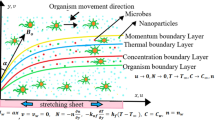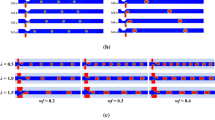Abstract
In this study, a micromixer with Koch fractal under electric field effect is simulated, and we studied the effects of different fractal parameters on the mixing process. These parameters include the number of fractals, the spacing of fractals, the geometric dimensions of fractals and the flow analysis of the fluid in the microchannels. Simulation displays that increasing the number of electrode pairs and increasing the fractal size are both beneficial to fluid mixing, and the optimal fractal spacing is 0.75 mm. The results show that the Koch fractal structure and the electric field effect can not only improve the flow state of the fluid effectively, but also increase the mixing index of the fluid.













Similar content being viewed by others
References
Nguyen NT, Wu Z (2004) Micromixers—a review[J]. J Micromech Microeng 15(2):R1
Han W, Chen X (2020) A review: applications of ion transport in micro-nanofluidic systems based on ion concentration polarization[J]. J Chem Technol Biotechnol 95(6):1622–1631
Abdelsalam SI, Mekheimer KS, Zaher AZ (2020) Alterations in blood stream by electroosmotic forces of hybrid nanofluid through diseased artery: aneurysmal/stenosed segment[J]. Chin J Phys 67:314–329
Dehghani T, Moghanlou FS, Vajdi M et al (2020) Mixing enhancement through a micromixer using topology optimization[J]. Chem Eng Res Des 161:187–196
Bazaz SR, Mehrizi AA, Ghorbani S et al (2018) A hybrid micromixer with planar mixing units[J]. RSC Adv 8(58):33103–33120
Hossain S, Lee I, Kim SM et al (2017) A micromixer with two-layer serpentine crossing channels having excellent mixing performance at low Reynolds numbers[J]. Chem Eng J 327:268–277
Raza W, Hossain S, Kim KY (2018) Effective mixing in a short serpentine split-and-recombination micromixer[J]. Sens Actuators B Chem 258:381–392
Chen X, Li T (2017) A novel passive micromixer designed by applying an optimization algorithm to the zigzag microchannel[J]. Chem Eng J 313:1406–1414
Chen X, Zhao Z (2017) Numerical investigation on layout optimization of obstacles in a three-dimensional passive micromixer[J]. Anal Chim Acta 964:142–149
Chen X, Li T, Li X (2016) Numerical research on shape optimization of microchannels of passive micromixers[J]. IEEE Sens J 16(17):6527–6532
Bayareh M, Ashani MN, Usefian A (2019) Active and passive micromixers: a comprehensive review[J]. Chem Eng Process 147:107771
Chen X, Zhang S (2018) 3D micromixers based on Koch fractal principle[J]. Microsyst Technol 24(1):2627–2636
Gidde RR, Pawar PM, Ronge BP et al (2019) Flow field analysis of a passive wavy micromixer with CSAR and ESAR elements[J]. Microsyst Technol 25(3):1017–1030
Lee CY, Wang WT, Liu CC et al (2016) Passive mixers in microfluidic systems: a review[J]. Chem Eng J 288:146–160
Xia HM, Wang ZP, Koh YX et al (2010) A microfluidic mixer with self-excited ‘turbulent’fluid motion for wide viscosity ratio applications[J]. Lab Chip 10(13):1712–1716
Wang Y, Zhe J, Chung BTF et al (2008) A rapid magnetic particle driven micromixer[J]. Microfluid Nanofluid 4(5):375–389
Ahmed D, Mao X, Shi J et al (2009) A millisecond micromixer via single-bubble-based acoustic streaming[J]. Lab Chip 9(18):2738–2741
Ding H, Zhong X, Liu B et al (2021) Mixing mechanism of a straight channel micromixer based on light-actuated oscillating electroosmosis in low-frequency sinusoidal AC electric field[J]. Microfluid Nanofluid 25(3):1–15
Ajarostaghi SSM, Delavar MA, Poncet S (2020) Thermal mixing, cooling and entropy generation in a micromixer with a porous zone by the lattice Boltzmann method[J]. J Therm Anal Calorim 140(3):1321–1339
Wu Z, Chen X (2019) Numerical simulation of a novel microfluidic electroosmotic micromixer with Cantor fractal structure[J]. Microsyst Technol 25(8):3157–3164
Zhou T, Wang H, Shi L et al (2016) An enhanced electroosmotic micromixer with an efficient asymmetric lateral structure[J]. Micromachines 7(12):218
Manshadi MKD, Nikookar H, Saadat M et al (2019) Numerical analysis of non-uniform electric field effects on induced charge electrokinetics flow with application in micromixers[J]. J Micromec Microeng 29(3):035016
Wu Y, Ren Y, Tao Y et al (2017) A novel micromixer based on the alternating current-flow field effect transistor[J]. Lab Chip 17(1):186–197
Nazari M, Rashidi S, Esfahani JA (2020) Effects of flexibility of conductive plate on efficiency of an induced-charge electrokinetic micro-mixer under constant and time-varying electric fields-A comprehensive parametric study[J]. Chem Eng Sci 212:115335
Chen X, Zhang S, Wu Z et al (2019) A novel Koch fractal micromixer with rounding corners structure[J]. Microsyst Technol 25(7):2751–2758
Acknowledgements
This work was supported by Young Taishan Scholars Program of Shandong Province of China (tsqn2020), Shandong Provincial Natural Science Foundation (ZR2021JQ).
Author information
Authors and Affiliations
Corresponding author
Ethics declarations
Conflicts of interest
The authors declare no conflicts of interest.
Additional information
Technical Editor: Erick Franklin.
Publisher's Note
Springer Nature remains neutral with regard to jurisdictional claims in published maps and institutional affiliations.
Rights and permissions
About this article
Cite this article
Xiong, S., Chen, X. & Ma, Y. Simulation analysis of micromixer with three-dimensional fractal structure with electric field effect. J Braz. Soc. Mech. Sci. Eng. 43, 332 (2021). https://doi.org/10.1007/s40430-021-03021-5
Received:
Accepted:
Published:
DOI: https://doi.org/10.1007/s40430-021-03021-5




